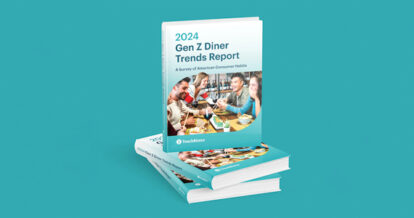Normally, it’s not too hard for restaurant owners to come up with New Year’s resolution ideas.
After the excitement (and expense) of the holidays, customers tend to disappear until Valentine’s Day rolls around, making January a good time for restaurateurs to implement some big business changes.
With fewer customers coming in after all your exciting New Year’s Eve restaurant promotions, combined with a little more time on your hands; January provides a unique opportunity for you to finally pull the trigger on some big changes. Resolutions like giving your menu a refresh or implementing a new restaurant POS could also save you some time and money later in the year.
To help you make the most of this coming January, we’ve curated a list of the best New Year’s resolution ideas for restaurant owners.
In this article, we’ll cover:
- Why January is the best time to set yourself up for a successful year
- Different New Year’s resolution ideas for restaurateurs
- How these resolutions can save you time and money
As they say: new year, new you.
Why January Is the Best Time for Change
While the idea of New Year’s resolutions is nothing new, you have the opportunity to think about them in a new way this year: namely, focused on your business.
Why?
Traditionally, January tends to be one of the slowest times of the year for restaurants. This is largely because consumers have made their own resolutions to save money or eat healthier in the wake of the holiday season. Not to mention, recent trends such as Dry January have shrunk the bill size of those who do venture out for a meal.
For restaurants, this dip in traffic and sales definitely unwelcome news. However, that doesn’t mean January should be a write-off. Rather, you can use the slow period as a time to strategize for the year ahead. Whether it’s testing out unconventional menu items or finally updating your restaurant technology, January gives you a chance to experiment with new restaurant business models that might set you up for success in the months ahead.

New Year’s Resolution Ideas for Restaurateurs
1. Get Organized
If there’s one takeaway from the past year, it’s that a restaurant reservations system can go a long way in helping you manage the flow of diners coming in and out of your restaurant.
If you’re still taking reservations the old fashioned way (with pen and paper), it might be time to rethink your process. Simply relying on the phone and a datebook not only makes it harder to keep staff in the loop, but it can also make it harder for guests to communicate their needs.
In contrast, implementing a digital reservation system can benefit everyone from your servers to your customers. Some of the biggest benefits of reservations include:
- Improved Safety: Digitally managing your reservations makes it easy to track venue capacity, space out bookings, and collect information for contact tracing (if necessary).
- Less Clutter: A modern reservation system can be managed through an iPad so you can ditch pens and paper on the host stand.
- Increased Accuracy: When customers input their own information online, there’s less risk for error or miscommunication.
- Predictable Wait Times: A reservation system optimizes table management so wait times are shorter and easier to predict.
- Automated Reminders: Reservation systems can help reduce no-shows by sending out automated reservation reminders to customers.
- Customer Profiles: You can ensure every guest feels like a VIP by keeping track of customer details such as dietary restrictions and special dates.
Of course, there are costs involved in setting up a restaurant reservation system. But if you use January as an opportunity to research the right option for you, you’ll reap the rewards in the long-run.
2. Be More Efficient
If the past few months revealed some holes in your operation, January is a perfect time to fix them.
And the first step in becoming more efficient? Look beyond using your POS transactionally, like a cash register, and make cloud technology your best friend – especially third-party integrations. These apps connect seamlessly with your restaurant POS so you can start controlling every part of the business from one central hub.
One of the most useful types of POS integrations is an accounting software application. With the help of apps like Shogo, you can map your sales data (by category or item) directly into your accounting software. The performance data is then posted directly from your POS into the accounting ledger at the end of each business day. This not only helps to prevent errors, but it also saves you from time-consuming manual accounting entries.
Of course, accounting isn’t the only task sucking up precious hours each week. POS integrations for reporting, scheduling, inventory management, and online ordering can also help you to streamline your operations and save you more than 30 hours each week – seriously!

3. Try a New Look
The new year is the perfect time to change up your look.
Though indoor dining may not be your biggest revenue stream right now, that won’t be the case forever. If you have the budget for it, January may be a good time to give your space a refresh. Implementing a well-designed restaurant floor plan can have a major impact on your restaurant’s profit margins by enhancing the guest experience, and improving overall efficiency through ease of movement and improved safety.
Part of a well-designed floor plan includes ensuring that your restaurant POS isn’t taking up a hefty chunk of your dining room. Luckily, most modern POS solutions are smaller and more portable, meaning they take up less space and give your servers the flexibility of tableside ordering. This also means more room for any off-premise restaurant operations.
And even if a major renovation isn’t in the budget, that doesn’t mean you can’t give your space an update. Something as simple as adding an outdoor sign or refreshing your window display can make a difference by better advertising your current offerings to potential customers.
4. Appreciate Your People
It’s been a rough year for restaurant workers and your current team probably looks a little different than it used to.
While you probably know the importance of having proper scheduling and HR systems in place, it’s easy for these things to slip during the busy season. However, letting issues such as understaffing or poor communication persist can lead to hostility and high employee turnover.
For the sake of your staff (and your own sanity), it’s worth taking the time to reevaluate employee processes such as scheduling and put proper processes in place.
Some tips for creating a more streamlined scheduling process include:
- Setting Expectations Early: Set expectations about proper scheduling procedures, such as filling out time off request forms and shift trading.
- Encouraging Open Communication: Use communication tools such as messaging apps to prevent overstaffing, understaffing, and burnout.
- Using Smart Scheduling Tools: Swap your pen and paper for scheduling software that lets you build and modify schedules on the fly.
- Providing Easy Access to Schedules: Use digital schedules so employees are always in the loop.
Not only can scheduling apps help you identify operational issues, but they also allow you to track and monitor employee engagement throughout the year. Through automated surveys, data-driven insights, and streamlined communication, you can identify those who are engaged and those who might be struggling.

5. Shrink Your Menu
Another lesson from the past year? A small menu is your best friend.
While you might think that more options is a selling feature, this isn’t always the case. When it comes to your menu (especially a takeout menu), too many choices can actually overwhelm customers and make it harder for them to decide.
The result? Customers will simply default to something they’ve had before.
To make sure that guests aren’t bewildered by your menu, use January as an opportunity to create a smaller, more currated menu. According to menu engineer Gregg Rapp, the ideal number of menu items per category is just seven. Seven appetizers, seven entrees, seven desserts, etc.. This is the magic number that encourages guests to try something new, without overwhelming them – bonus points if some of those star dishes are higher-margin items.
If you’re stuck on which menu items to cut and which ones to keep, your restaurant POS can offer some great menu management insights. Your POS can show you which items are best-sellers and exactly how much they’re bringing in. You can dive even further into the data by looking at items that are frequently purchased together and then update your menu to promote cross-selling.
And while you’re in the process of giving your menu an overhaul, keep in mind the importance of design. When overhauling your physical and digital menus, employ design strategies such as using photos sparingly or grouping dishes by category to ensure the items you do include return the biggest profits.
6. Enter New Markets
Not only is delivery the perfect cure for a New Year’s Day hangover, but it could also be key to success in the new year.
If you’ve been watching the rise of food delivery apps with a wary eye, we get it. Implementing a delivery service can require some upfront work and take time to establish proper workflows. But these concerns make a slow month like January the perfect time to start thinking about augmenting your current takeout business and implementing delivery.
If you opt to keep delivery in-house, you’ll need to set up your own restaurant online ordering system and hire drivers to facilitate deliveries. While this is a lot more work on your part, the bonus is that you get to keep all the delivery profits.
On the other hand, you could work with a third-party delivery service like DoorDash or UberEats to fulfill your online orders. However, in this scenario, you’ll have to pay for setup and share 10% to 40% of each transaction with the app provider.
No matter which route you choose, implementing an online ordering system offers a multitude of long-term benefits, including:
- Safer Dining Experience: Offering options like no-contact delivery allows you to safely serve customers without any face-to-face interaction.
- Increased Check Sizes: Restaurants that implement online and delivery orders generally see a 20% increase in check sizes.
- New Revenue Sources: Offering delivery lets you serve an entire segment of people who prefer to enjoy their meals at home or don’t feel comfortable dining out.
- Less Overhead: Delivery orders require less table space and fewer front-of-house staff, which can help you save on operating costs.
- New Customers: Third-party apps put your restaurant in front of thousands of new customers who might not have heard of your restaurant otherwise.

7. Measure Success Regularly
Bear with us because one of our last New Year’s resolution ideas involves a little bit of homework.
We’re talking about your POS reports and analytics.
Admittedly, this isn’t the most exciting topic, but letting these reports gather dust means you could be missing red flags that could cost you thousands. If these reports are something you’ve been relegating to your junk drawer, January is the perfect time to get back on track.
To start, these are the top business reports you’ll want to take a look at:
- Snapshot Report: A live report of your business at the current moment, including revenue, cost of labor, and CoGS.
- Discounts & Voids Report: Reveals how much you’re doing in discounts and voids.
- Sales by Order Type: Shows you the breakdown of sales in categories such as takeout, delivery, dine-in, and bar tab.
- Heatmap: Gives you a breakdown of how much money is coming in each hour to show you your busiest time periods.
- Sales by Menu Item: A breakdown of sales per menu item over a set reporting range.
- Labor Costs Analysis: Reveals your labor costs over a longer period of time (unlike a Snapshot report).
- Payment Details Report: Reveals every payment processed at your business, including details such as which staff member processed the payment.
- Weekly Target Reports: Helps you set different business targets and track your performance.
- Menu Analysis: Shows you the performance of each menu item.
- Drill Down Report: Gives you an hour-by-hour breakdown of sales.
While this may sound like an overwhelming amount of reports to keep track of, it’s easier than you think – if you have a modern POS system. Your restaurant POS can do the number crunching for you and automatically email you a comprehensive end-of-day summary.
With regular reports, you can begin to pull insights that will help you set better restaurant goals, and make more informed business decisions throughout the year.
For example, one Brooklyn restaurant was able to reduce its non-alcoholic CoGS rate by 6% with information from TouchBistro’s Sales by Menu Item report. Similarly, an international fast casual chain used our Heatmap reports to streamline production and reduce waste by 11%. In other words, it pays to check your restaurant reports!
While these New Year’s resolution ideas may seem like a lot to tackle in just a month or two, making these changes now can help you adapt to an industry that is in a major state of change. And keep in mind that you can kill two (or more) birds with one stone by simply updating your restaurant POS. With a modern POS, you can tackle everything from revamping your floor plan to adding commission-free online ordering, all at the same time.
Who said January has to be a lost month?
Free Restaurant Cleaning Checklist
Sign up for our free weekly TouchBistro Newsletter







